

 The Accurate Reloading Forums
The Accurate Reloading Forums  THE ACCURATE RELOADING.COM FORUMS
THE ACCURATE RELOADING.COM FORUMS  Hunting
Hunting  African Big Game Hunting
African Big Game Hunting  Ingudula the Tuskless One
Ingudula the Tuskless OneGo  | New  | Find  | Notify  | Tools  | Reply  |  |
| One of Us |
Ingudula the Tuskless One By Kevin Thomas© Zimbabwe’s various tribal groupings have names for tuskless cow elephant, the Batonka call them chikubule or magumpu, in Shona they’re nzuma or mbumule and in Ndebele ingudula, although I’ve never been able to get a literal translation of any of the meanings. Tuskless elephant cows afford an exciting hunt, as by nature they’re normally aggressive if they feel threatened (this is partially through frustration at not having tusks as an all important feeding tool and defensive weapon). A tuskless cow hunt is also a form of management hunt because Zimbabwe’s National Parks department tries to reduce by sport hunting, the number of cows carrying the tuskless gene. October in Zimbabwe, known as ‘suicide month’ is hot and in places humid, although my client Chris Soyza from Westley Richards in the UK is a native of Malaysia and not intimidated by heat. He was keen to shoot a tuskless cow in a short duration 5-day deal. Due to a bureaucratic glitch in the small print Britain’s arms embargo against Zimbabwe includes sporting guns, so Chris used my .375 H&H with South African PMP Super 286grn factory loaded monolithic solids. For my part while guiding Chris, I would be carrying my .458 Lott and prior to departure had handloaded a bunch of 475grn PMP Super monolithic solids, using 83grns of S321 (a South African produced fast burning ball propellant) and CCI 250 Large Rifle Magnum primers, my brass was unused Hornady. We drove into the concession a day earlier than planned and with the smoky haze hanging heavy in the windless late afternoon air finally left most of the tribal villages behind, and then east of the Chirisa Safari Area’s Masikiri escarpment, drove into the rugged ridges of the Madzivazvido region of the Gokwe North council hunting area. Tshabezi Safari’s main camp has no mod-cons and can best be described as rustic but comfortable. After being met by the jovial camp crew and unloading, we still had enough light for Chris to test fire my .375 H&H and check the zero. His shooting at paper from 50m was spot on, so after a quick lunch we hunted to the south only to find that the entire area had been burnt and by last light we were back in camp. When the anti-poaching patrol returned, they too, reported no sign of elephant within that part of the concession, and on hearing this we retired to the campfire for a few pegs of the amber liquid and to talk tuskless elephant cow hunting. Earlier in the day a buffalo cow had been shot for a council function and camp chef Chuma, knowing my predilection for buffalo tail, buffalo tongue, and the inside tenderloin, had ensured they were removed and placed in the camp freezer for use during our safari. Chris who’s a chef par excellence and had previously volunteered to share his skills with Chuma, wasted no time in visiting the kitchen and despite the limited ingredients he had at his disposal he soon had a superb buffalo tenderloin curry on the go. Following the dinner, we retired to our chalets replete. Prior to our arrival I’d already decided that I’d prefer to hunt out of Kausige Camp on the Ume River floodplain, little more than a ‘fly-camp’ with chalets on stilts it is situated 20km away from the main Tshabezi camp but is out of sight of tribal villages, cattle bells, braying donkeys, barking dogs, beating drums, and all else that goes into the make-up of a rural Zimbabwean tribal community. Having briefed the camp staff of my intent we got an early night and at first light the next morning ate a quick breakfast then departed for Kausige with the trackers and council game scout Adam, leaving the rest of the camp staff to follow in a second vehicle with the camping gear and rations. After settling in we hunted the higher elevations west of the Ume River where the bush was rapidly greening; seemingly, and from the abundant sign we saw, elephant groups were moving in numbers towards this rich food source. We then traversed the vlei lines, scenically attractive places with verdant grass and plentiful crystal clear spring water; however, they lacked abundant wildlife of any sort, or sign thereof. Currently, poaching in Zimbabwe is a hugely serious issue, much of it poverty driven due to the country’s poor governance. Private safari operators working in the CAMPFIRE areas are doing all that they can to try and control it by way of employing anti-poaching teams, but it is a daunting task and the sustainable long term future of safari hunting in some of these areas is extremely worrying. The springs we visited though, had plentiful elephant sign, if nothing else. Spoor indicated far larger groupings than the normal 8 to 12 in a cow herd, and the tracks invariably led into the dense jesse thickets. During the rainy season leaf cover limits visibility, however, in October visibility is generally fairly good although the ground is carpeted with dry fallen leaf matter which is noisy – almost like I’d imagine walking on a bed of cornflakes to be. Elephant rest during the midday heat, and closing with a cowherd on the noisy leaf cover is tricky, so in the dry months, I prefer to hunt them when they’re feeding, their noise drowning out the hunters’ approach. Late afternoon saw us walking through a jesse thicket towards a spring where hopefully we’d either intercept a herd, or find them at the spring, and if there was a shooter in the herd, follow them away from the spring before carrying out any gunning exercise. At the spring we found no sign of elephant, and then when taking a different route back to the vehicle, we cut fresh spoor crossing the road and re-entering another thicket. Tracker Getas, a local, who’d tracked in the area for years felt the herd was returning to a spring we’d visited earlier in the day. With this in mind we drove part of the way, and then quickly walked through the brush to the spring, but of elephant there was no sign, and with shooting light gone, we returned to the truck and about 80m from the vehicle found a bull elephant – he stood motionless and broadside on – listening, then turned and with raised head tried to make us out, his tusks were only about 20lb a side and once he’d identified the threat he hurriedly disappeared into the woodland gloom, and with that, our day too, came to closure. On our next foray, and some way west of camp we came across spoor of a large cowherd where they’d crossed the road, we also found fresh dung, the acrid odour strong on the breeze. It was warm to the touch and mucous covered. Chewed branches were still damp with traces of saliva; a viable follow up was in the offing. Wind direction is absolutely critical when hunting dangerous game and my preferred method of monitoring wind is by using an ash bag – a slight flick of the wrist releasing a cloud of fine ash, for this reason I carry an ash bag in my left hand shirt pocket, most competent trackers also carry one. Having re-checked our rifles and water stocks, plus whatever else we needed for the hunt, we took up the spoor. As we went deeper into the bush elephant sign became more apparent, it was also clear to us that we were following a fairly large grouping. The trail led steadily south for about 2km and thinking we still had some way to go, it was pleasing to suddenly hear ahead of us the unmistakable sound of a branch breaking so we quickened our pace. We couldn’t see anything to our front, with the new miombo leaf flush and dense stands of thin saplings forming an effective screen. While focused on what was to our front, we then also heard elephant off to our immediate left and not far away, so with the wind still blowing nicely in our favour, we cautiously moved in the direction of these new elephant feeding sounds. As we got closer we began to once more smell the strong elephant odour, when suddenly an elephant trumpeted loudly so we froze, then relaxed, tracker Getas nonchalantly whispered that elephant always trumpet when they know one of their number is going to die! Continuing towards the noise of the feeding herd, it didn’t take long before we had some of their number visual, large grey beasts, moving steadily forwards in an awesome display of musculature and intimidating power. Due to the greenery all we could see was the top of their heads and backs, nothing else. There was no lingering whilst they fed, it was all steady progression and we initially had to lengthen our stride to stay parallel with them. When we’d got closer to the lead elements, we stopped, and quickly glassing them I observed a few tuskless cows, there was also a big bodied bull, with thin ivory lacking both length and circumference at the lip. His presence was probably due to a cow in oestrus. My first impression was of the abnormally high number of elephant in the group, it looked like there were about thirty. Probably a gathering of different cowherds and it could have been for either security or food. I was still pondering this thought, when a tuskless cow’s head and upper shoulders suddenly appeared in an opening in the greenery. She was feeding broadside on, and although young she was breeding mature, however, a quick look through the cover around her immediate environs showed no sign of a dependent calf. Shooting a tuskless cow with a dependent calf isn’t only highly unethical; it can cause all sorts of problems for the PH with the authorities. Grabbing the shooting sticks from Getas I quickly opened them and in seconds Chris was settled and looking at the sight picture through the scope. Early in the hunt we’d decided to only use a brain shot and a side brain had presented. As Chris readied himself, by habit I quickly brought the Lott hard into my shoulder and with both eyes open, giving me 180° field of view, waited. It wasn’t long in coming and at the loud report of the .375 H&H the cow immediately threw her trunk and head up high, her hind legs collapsing as if pole-axed, and she disappeared from view. There was no need for an anchor shot from Chris. In the immediate aftermath, the herd spun as one and tightly bunched, fled south, then whilst we were congratulating Chris on a well-placed shot, council game scout Adam with eyes wide suddenly started to retreat. It was then that we heard a rapidly approaching noise and saw the cause – a wall of elephant shoulder to shoulder were headed straight back towards us at high speed. They weren’t charging us but had turned through 180º and were merely trying to flee, having not been able to place where the noise of Chris’s single shot had come from. This kind of situation can quickly become dangerous if there’s a loss of control and the “dickey bird syndrome” takes over. Human beings are incapable of outrunning an elephant herd, and it would be folly to try. If panic takes hold and everyone runs blindly ahead of the fleeing elephant, individuals will get injured or worse. It only takes one tracker to lose his composure and do a runner, and unless the PH can keep a firm grip, it rapidly becomes infectious and the whole hunting crew decamp. If trackers know and trust the PH this situation is unlikely to occur, but with inexperienced trackers and arbitrary game scouts tagging along there is the possibility. Chris and I had previously discussed such a scenario, and because he is an experienced hunter I’d requested that if we faced a situation where a shout-down was needed and it failed, then I wanted him to immediately use my .375 H&H to put a shot over the elephant to turn it/them. If that too failed, I’d be forced to take more drastic action with my .458 Lott. In the few seconds we had left to inform the rapidly advancing phalanx of elephant of our whereabouts, shouting at the top of my voice and in the vernacular I admonished the game scout for running, and then Chris and I both shouted at the elephant herd whilst he also put a shot over their heads. It worked, and at about 35m to our front they spun to their right as if it had been choreographed, and in a huge cloud of dust the grey mass disappeared. Chris had taken his shot from about 30m and I was relaxed with him shooting from that distance – the .375 H&H like the .416 Rigby and the .404 Jeffery is an extremely flat-shooting calibre. We were not culling elephant cows and only wanted to kill a single tuskless individual. Chris is an extremely competent shot and with a herd that size, coupled to the brush they were in, the distance gave us plenty of manoeuvrability if something had gone wrong. Elephant have a highly developed social structure and even the removal of a single cow is stressful, and extremely disruptive to the remainder, thus I like to try and do it as clinically as possible. If the herd had gathered around the fallen one, and turned aggressive, we would have pulled back and waited their eventual moving off. When we got to the dead cow, her head still had a slight brain tremor, so Chris gave her a coup de grace. It is always after an elephant has been shot that the hard work begins, and in this case after the photo session, we drove to the main camp to collect the labour and skinners. They then cut a track in from the closest point on the road to the elephant, where it was skinned and butchered. Later at the skinning shed the skinner found the bullet in the skull and it showed some erosion on the shank, no doubt from contact with bone.  Kausige is an extremely rustic camp on the banks of the Ume River.  All the springs had been visited on a regular basis by elephant cowherds. 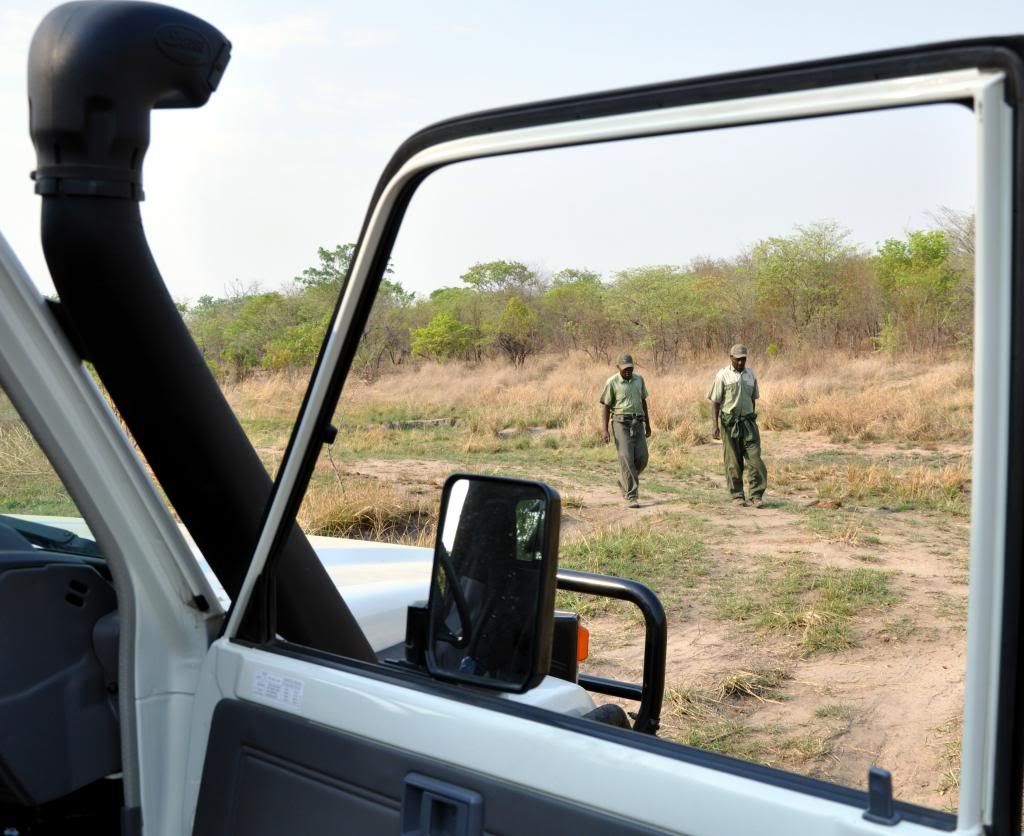 The trackers returning to the vehicle after scouting for spoor at a waterhole.  Bush loo without a view!  Given that you’re usually only there after sunset and gone before sunrise, the fly-camp accommodations served the purpose – Photo credit Chris Soyza. 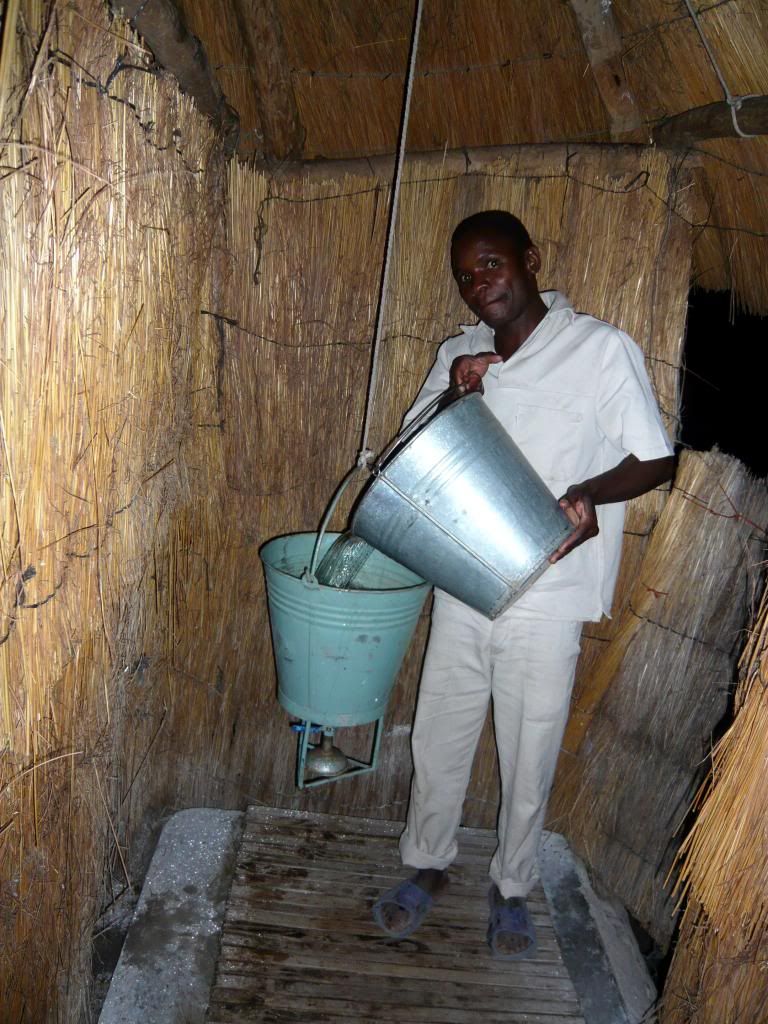 Kasina pours the shower water – Photo credit Chris Soyza. 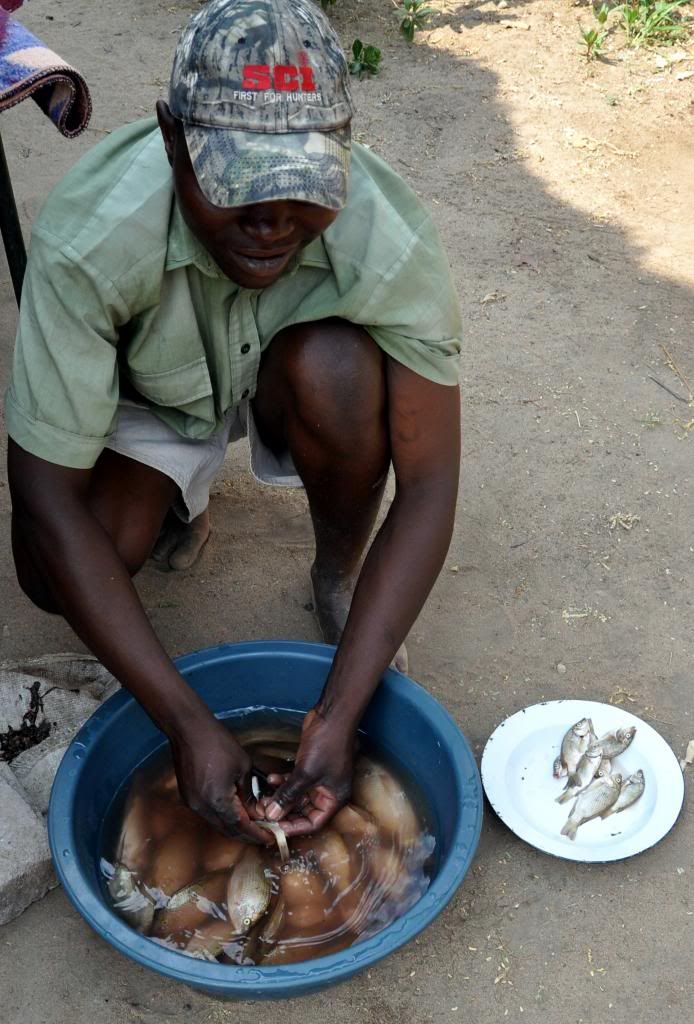 Tracker Chucks cleans some small tilapia caught in the pools on the river, gutted & deep fried they made good campfire snacks. 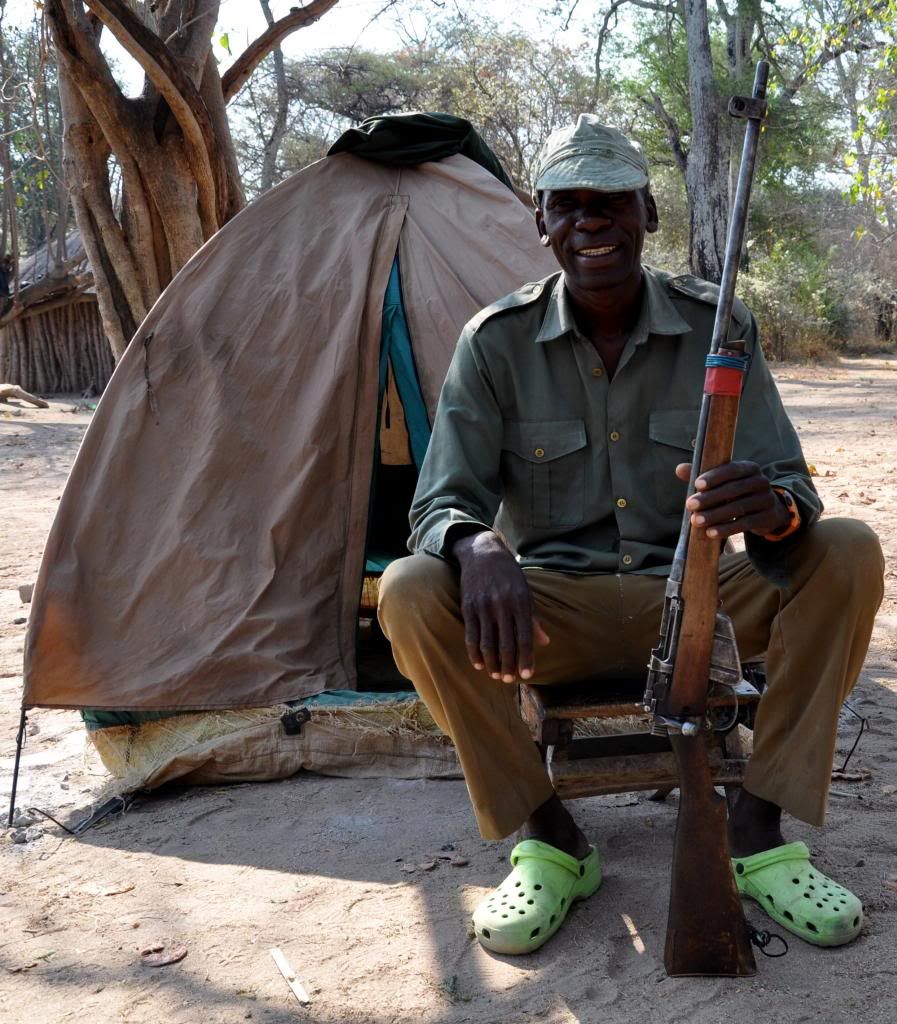 Gokwe North Council Game Scout Adam relaxing with his battered .303, the butt had about 6” of lateral play – not much use against AK47 wielding commercial poachers. 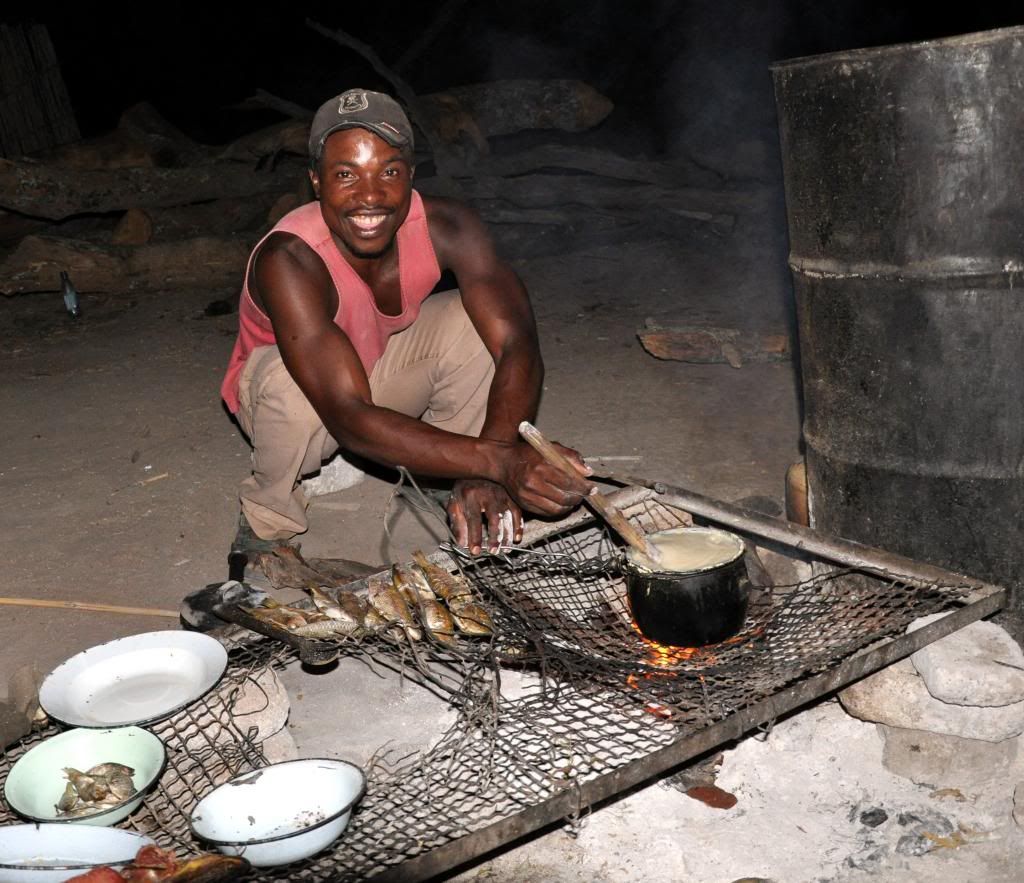 The anti-poaching patrol game scouts also kept us abreast of cowherd movement, and after a long day of patrolling, one prepares his evening meal. 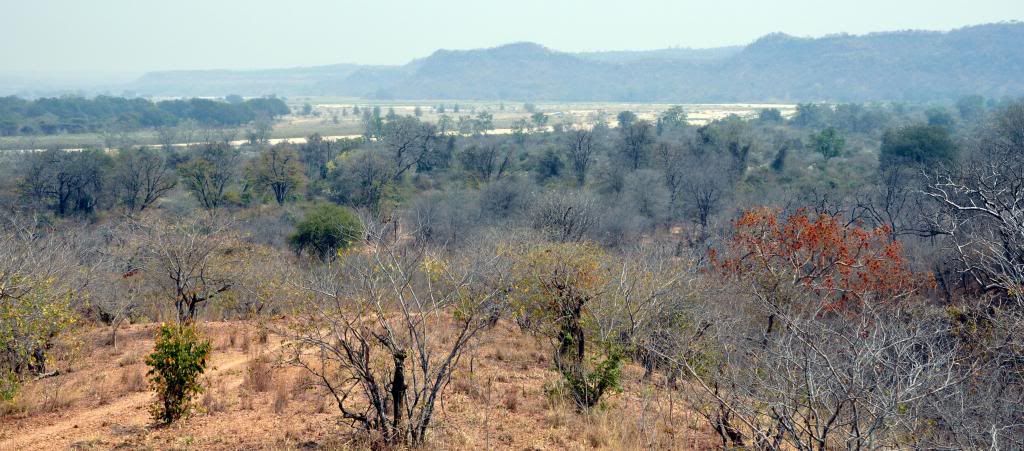 October haze across the Ume River valley. 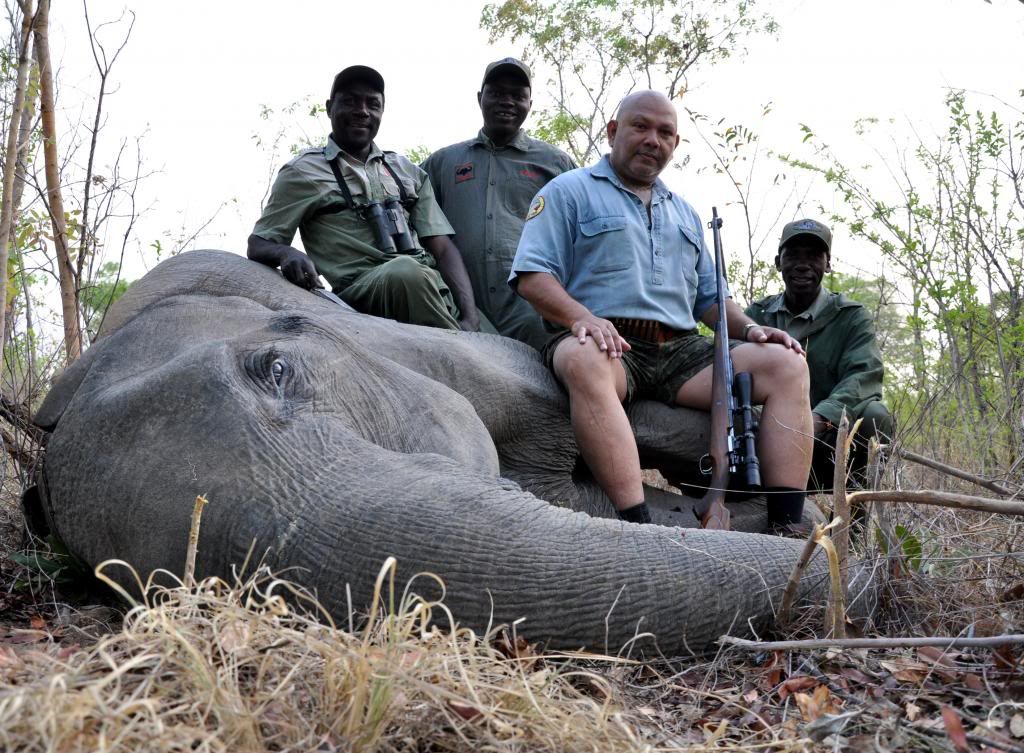 Chris Soyza with his tuskless elephant cow, and from left rear trackers Getas & Chucks, with Game Scout Adam squatting.  After a successful elephant hunt the hard work begins, however, in Africa there is no wastage of protein, and all that is ultimately left is the gut content which is soon cleaned up by scavengers. 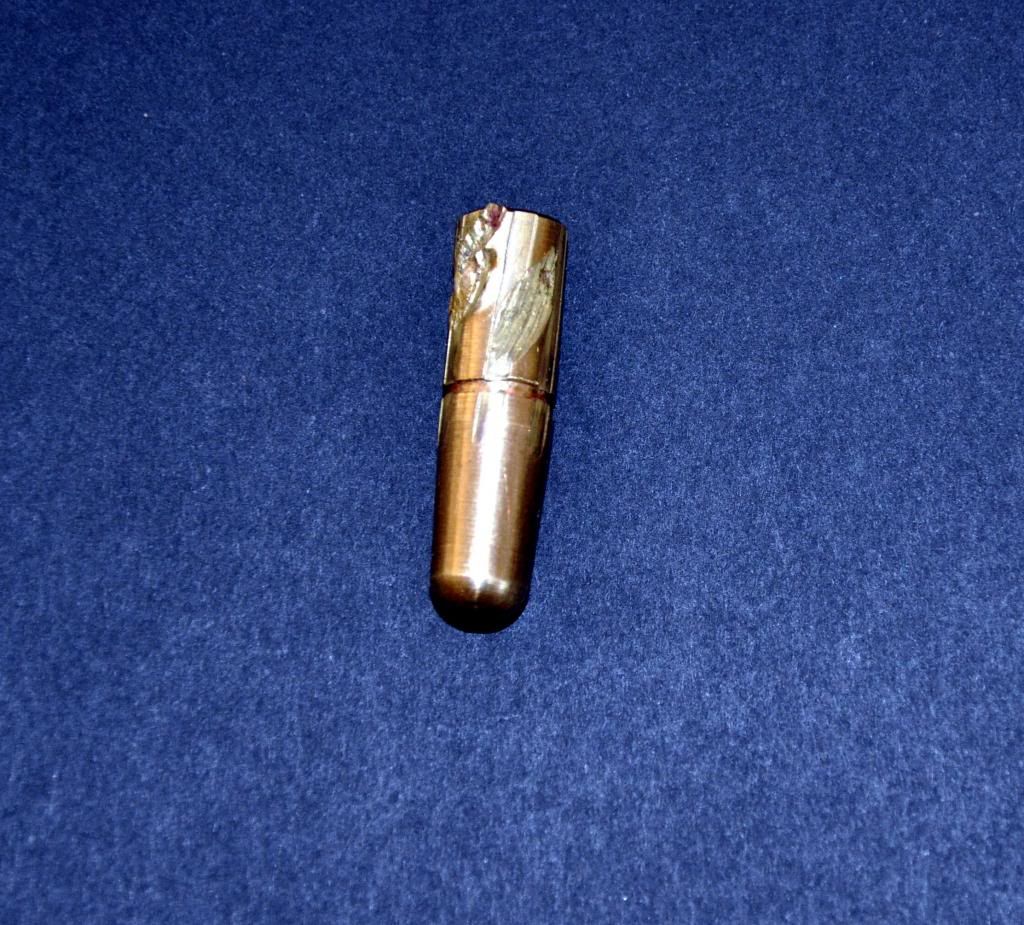 The .375 H&H 286grn PMP Super monolithic solid recovered from the skull showed some erosion on the shank, probably from contact with bone. Kevin Thomas Safaris Zimbabwe - Eastern Cape E-mail: ktsenquiries@mweb.co.za Website: www.ktsafaris.co.za | ||
|
| One of Us |
Love the "Bucket" shower | |||
|
One of Us |
Thanks for a well written story and nice pictures. I'll hunt Gokwe North in September next year, so nice to see pictures from there :-) Torbjorn | |||
|
| One of Us |
Great reading from a well written piece! DRSS Sabatti 450\400 NE Merkel 140-2 500 NE | |||
|
| One of Us |
My first Zim safari was in that camp. I loved it, rustic but comfortable and the bucket shower worked great. Getas was my tracker, great tracker, glad to hear he is still involved in Gokwe North. I shot my first bull elephant there down in the Ume jesse. Very nicely written report, thanks and congrats to the hunter. BUTCH C'est Tout Bon (It is all good) | |||
|
| One of Us |
KEVIN, ENJOYED YOUR WELL WRITTEN REPORT ON 'THE TUSKLESS ONE',MORE PLEASE.WELL DONE CHRIS SOYZA FOR MAKING IT HAPPEN.JC | |||
|
| One of Us |
Really cool report. Enjoyed in emensly. | |||
|
| One of Us |
Nice report and pics! | |||
|
| One of Us |
I too took my first elephant in that area. Getas was my tracker as well. I am glad he is well & still at it as he is great at what he does. I spent time in that camp. Thanks for bringing back some great memories. | |||
|
| One of Us |
Kevin: Enjoy reading your reports. Have a couple short questions. What's the altitude in some of those areas? And what's the typical temp? Thank you, be safe and congrats to Chris. George "Gun Control is NOT about Guns' "It's about Control!!" Join the NRA today!" LM: NRA, DAV, George L. Dwight | |||
|
| One of Us |
Hi George, to answer your questions. The altitude varies between 550m - 700m. Temperatures in October can range between 32⁰C (89.6⁰F) - 42⁰C (107.6⁰F) Regards, Kevin Kevin Thomas Safaris Zimbabwe - Eastern Cape E-mail: ktsenquiries@mweb.co.za Website: www.ktsafaris.co.za | |||
|
| One of Us |
Kevin: You did it again. Good writing, good story. JDK | |||
|
| One of Us |
Thanks Kevin, I really enjoy your post. A good friend of mine, Huston Broughton, that hunted with you some years back says your a man to ride the river with. | |||
|
| Powered by Social Strata |
| Please Wait. Your request is being processed... |
|
 The Accurate Reloading Forums
The Accurate Reloading Forums  THE ACCURATE RELOADING.COM FORUMS
THE ACCURATE RELOADING.COM FORUMS  Hunting
Hunting  African Big Game Hunting
African Big Game Hunting  Ingudula the Tuskless One
Ingudula the Tuskless One

Visit our on-line store for AR Memorabilia

